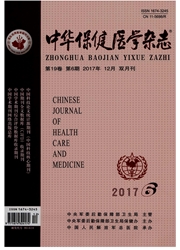

 中文摘要:
中文摘要:
目的检测冠心病患者内皮脂酶(EL)阳性循环内皮细胞比例(EL+/CECs),分析其与冠心病常见危险因素间的关系。方法107例急性冠脉综合征(ACS)患者和69例稳定性心绞痛(SAP)患者经冠脉造影证实有明显冠脉狭窄;经临床检查有危险因素,而冠脉造影无明显狭窄的82例患者为对照。采集肘静脉血液标本,检测血脂、血糖、高敏C反应蛋白(hsCRP)等。分离循环内皮细胞(CEC),以免疫组化法检测循环内皮细胞中EL的表达,并计算EL+/CECs。所有研究对象收集常见冠心病危险因素(如冠心病家族史、吸烟史、高血压病史、体重指数等),分析EL+/CECs与危险因素间的关系。结果对照组患者的一般情况与冠心病患者差异无统计学意义,但EL+/CECs在各组间差异有显著统计学意义(P〈0.05),以ACS组值最大,对照组值最小。以EL+/CECs比例均数为基准,发现高于EL+/CECs均数的患者较低于均数组患者其冠心病家族史、吸烟史、糖尿病、低HDL血症等危险因素显著增强(P〈0.05),多元线性Logistic回归分析提示冠心病家族史、吸烟史、糖尿病、低HDL血症、LDIJHDL比值和hsCRP对EL+/CECs有重要作用(P〈0.05)。结论EL+/CECs与冠心病临床危险性呈正相关,受冠心病多种危险因素的综合影响。
 英文摘要:
英文摘要:
Objective To evaluate the relationship between the ratio of positive circulating endothelial cell(CEC) expressing endothelial lipase to total CECs(EL+/CECs) and the risk factors of coronary artery disease(CAD). Methods According to angiography examination, 107 patients with acute coronary syndrome(ACS),69 patients with stable angina pectoris(SAP) and 82 patients excluded coronary artery disease as control,were studied. Risk factors of CAD including family history of CAD,smoking,diabetes,hypertension, body mass index (BMI)et al ,were collected. Blood samples were collected from ulnar vein and biochemical indicators including blood lipid level, serum glucose, hsCRP, et al were detected. Circulating endothelial cells(CECs)were separated. EL was detected by immunohistochemistry and the ratio of EL+/CECs was calculated. Results EL+/CECs was significantly different among groups ACS, SAP,and control group. The EL+/CECs in the ACS group was the highest among three groups. In patients whose EL+/CECs was higher than average level, risk factors such as the family history, smoking, diabetes ,lower HDL level et al, were stronger than those whose EL+/ CECs was lower than average(P〈0.05). Regression analysis indicated that the EL+/CECs was affected by the risk factors as family history of CAD, smoking, diabetes,lower HDL level, LDL/HDL, and hsCRP level. Conclusions EL+/CECs is positively correlated to the clinical dangerous degree of CAD and is affected by risk factors of CAD.
 同期刊论文项目
同期刊论文项目
 同项目期刊论文
同项目期刊论文
 期刊信息
期刊信息
